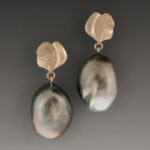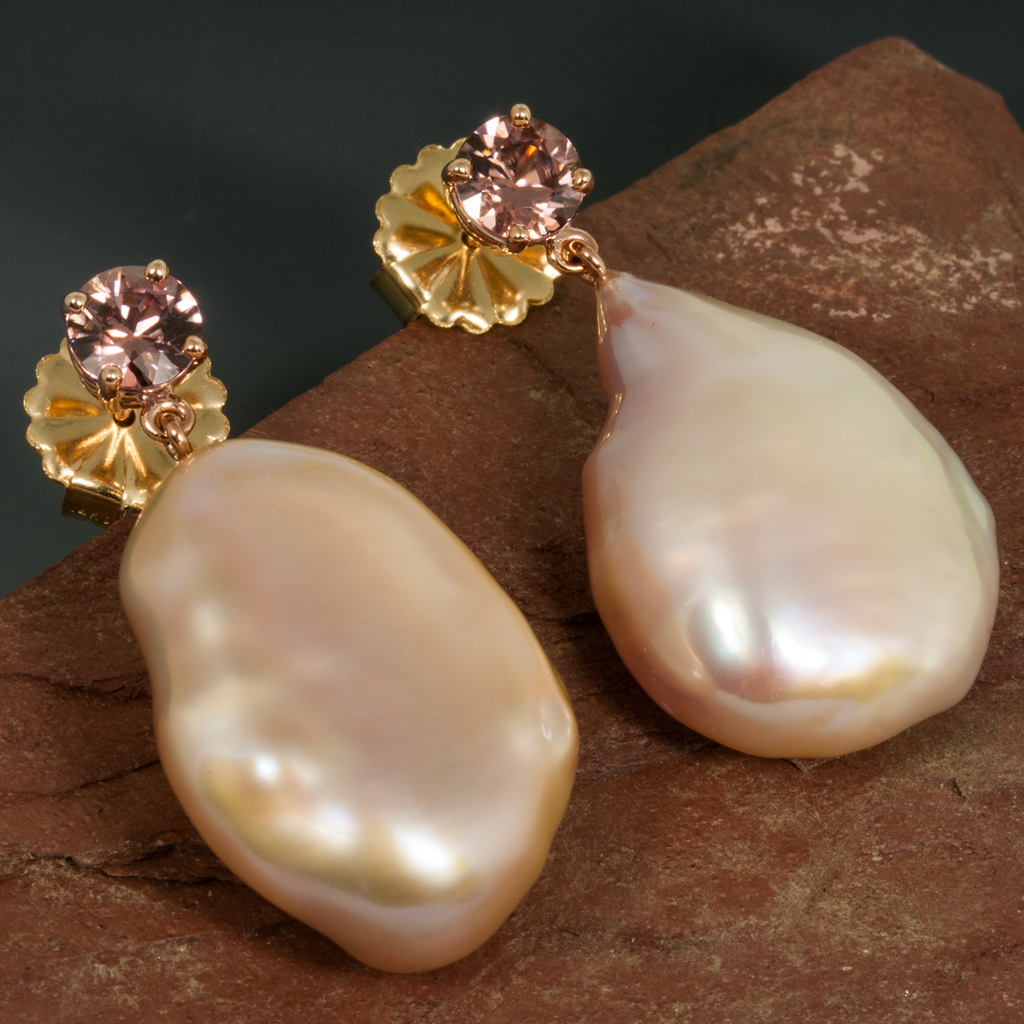
Most recently created by hand in our workshop, Lenox, MA, in the Berkshires. These earrings feature a matched pair of pink zircon with large pink baroque pearl drops set in 14K red gold. Dramatic and elegant!

Most recently created by hand in our workshop, Lenox, MA, in the Berkshires. These earrings feature a matched pair of pink zircon with large pink baroque pearl drops set in 14K red gold. Dramatic and elegant!
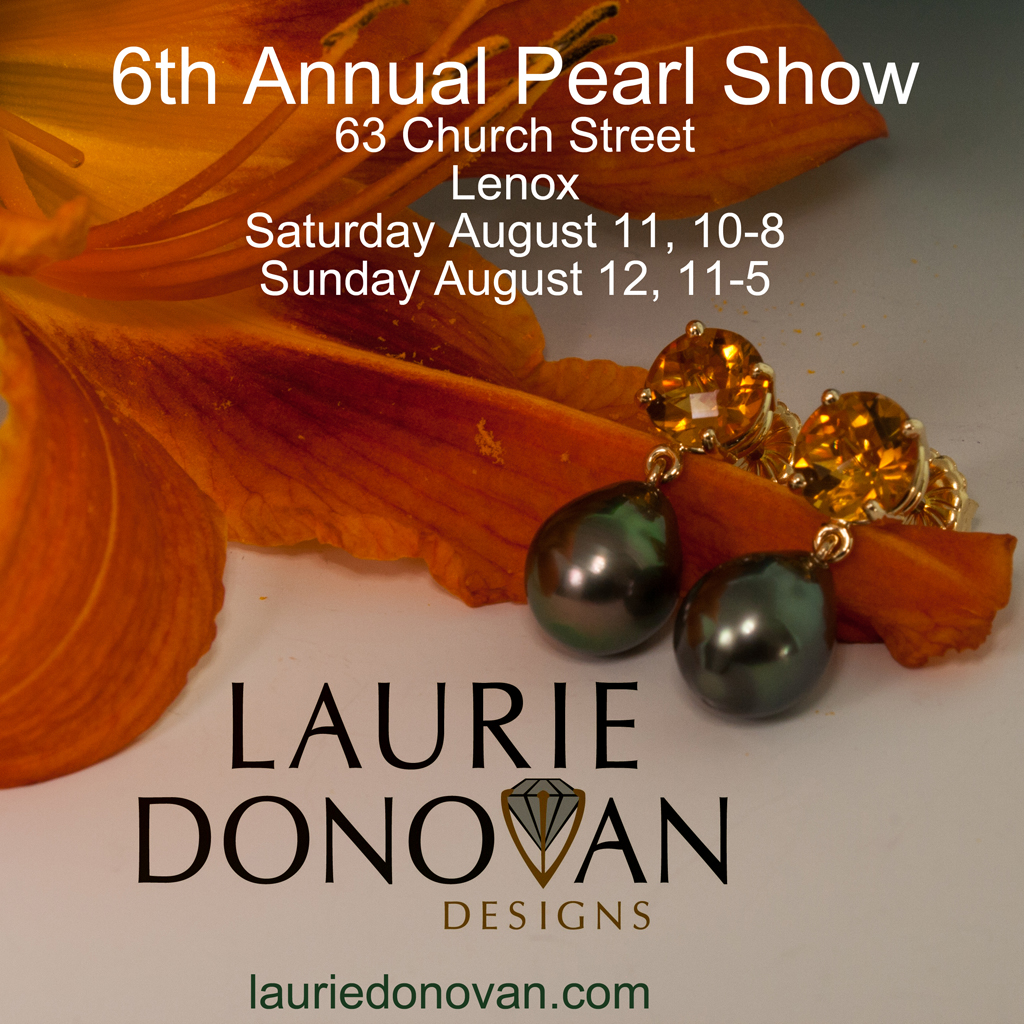
Saturday, August 11, 10-8 and Sunday, August 12, 11-5.
Come in to our new gallery and see unique pearl pieces recently created in our workshop. Also on display will be strands of pearls of many colors, shapes, and sizes. Our jewelry features Black Tahitian, Peach Coin, White Baroque, White Fresh Water Drops and more. Be sure to come in and talk with our pearl expert on Saturday.
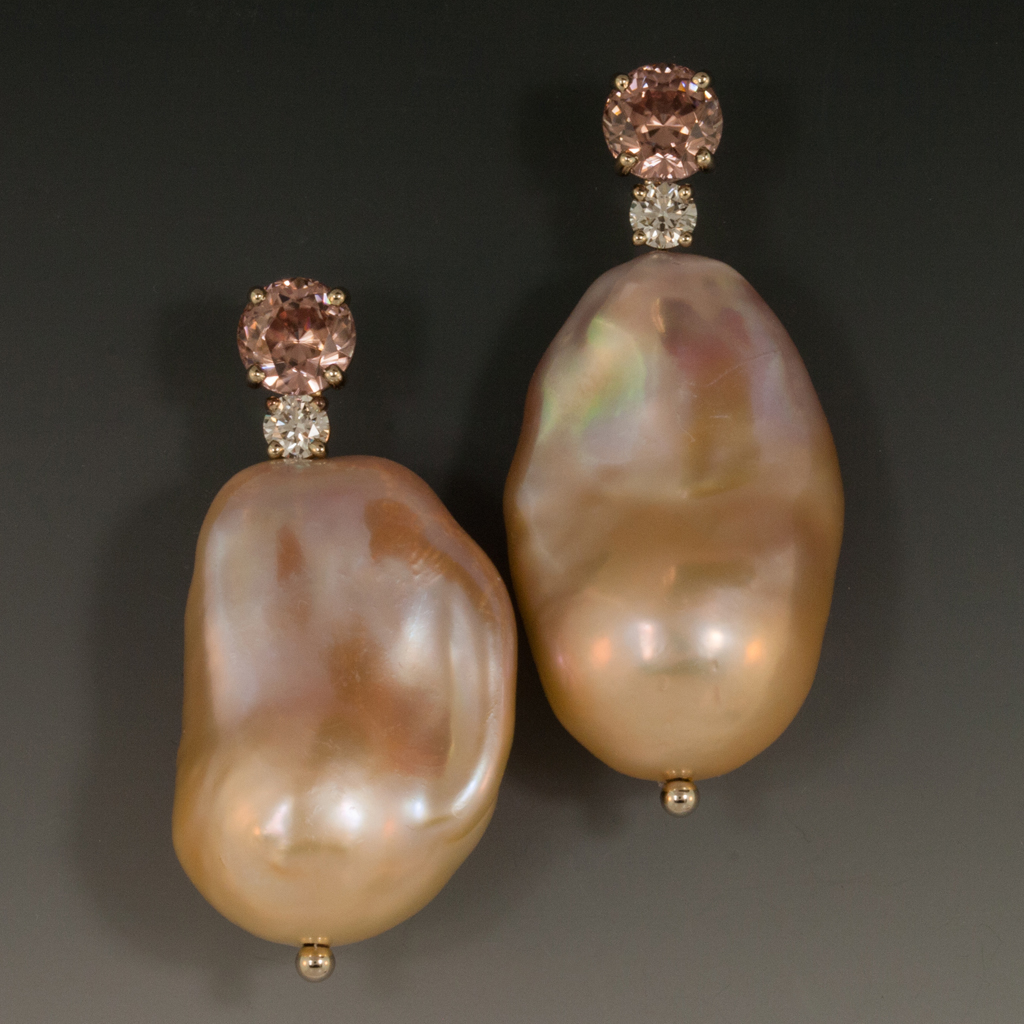
Made by hand in our workshop in the Berkshires! Earrings, Large Peach Freshwater Baroque pearls drop from matched peach zircons with diamonds set in 14K white gold. The pearl drops are removable making these “Day/Night” Earrings.
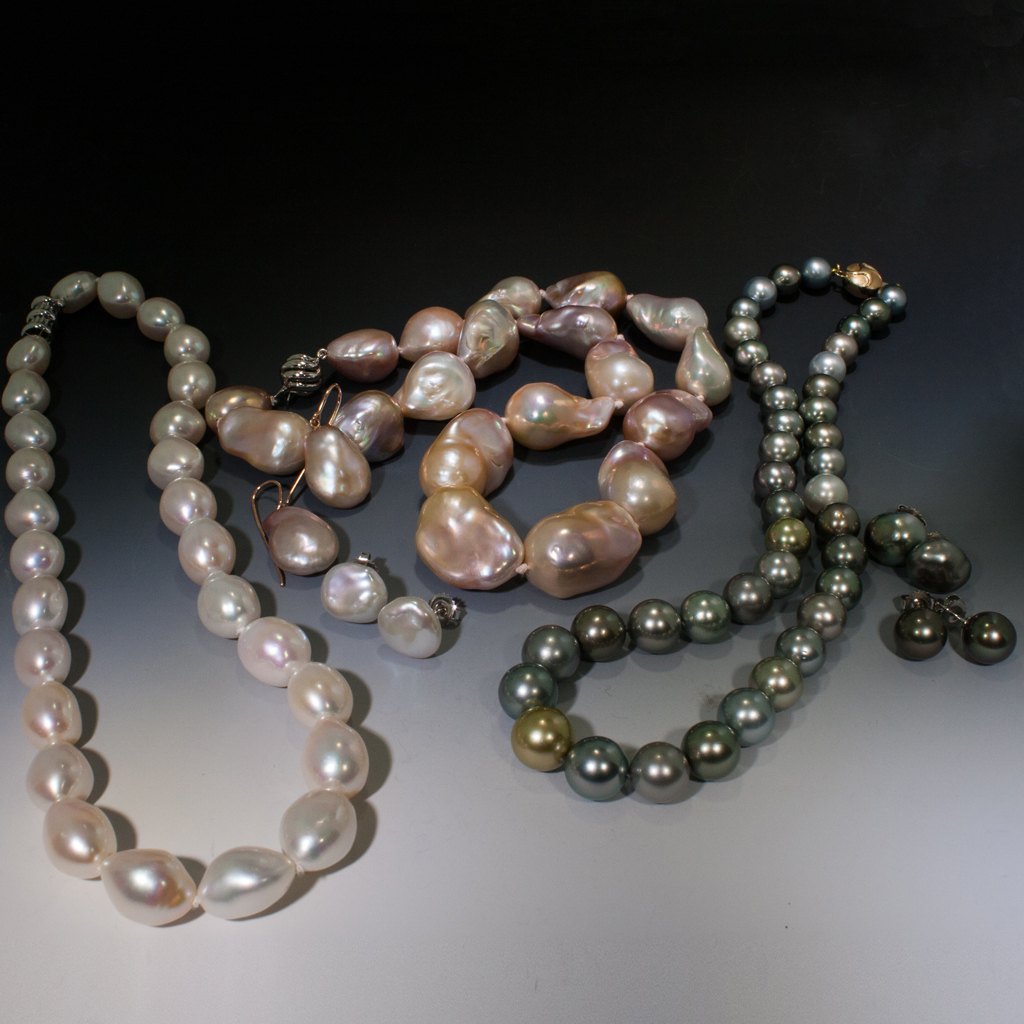
A pearl is a hard glistening object produced within the soft tissue (the mantle) of a living shelled mollusk. The ideal pearl is perfectly round and smooth, but many other shapes, known as baroque pearls, can occur.
Natural Pearls occur spontaneously in the wild and are extremely rare. Cultured or farmed pearls from pearl oysters and freshwater mussels make up the majority of those currently sold.
Whether natural or cultured, gem quality perals are almost always nacreous and iridescent, like the interior of the shell that produces them.

A Quick Guide to Pearl Types
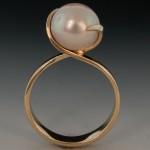 Akoya – Lustrously Delicate. Cultured Pearls farmed in Japanese and Chinese ocean water, created by a type of oyster called Pinctada fucata martensii; The “Akoya Pearl” Oyster. Usually found in sizes of 2 – 8mm with 8 – 10mm considered very large for Akoya pearls. Known for their white to cream coloration, while Japanese value a very slight pink tone. They are valued for their mirror-like luster and depth (orient).
Akoya – Lustrously Delicate. Cultured Pearls farmed in Japanese and Chinese ocean water, created by a type of oyster called Pinctada fucata martensii; The “Akoya Pearl” Oyster. Usually found in sizes of 2 – 8mm with 8 – 10mm considered very large for Akoya pearls. Known for their white to cream coloration, while Japanese value a very slight pink tone. They are valued for their mirror-like luster and depth (orient).
Tahitian – Black and Bold. Cultured pearls farmed in Polynesian ocean water, created by the Pinctada margaritifera oyster or the “black-lip oyster”. These oysters are larger and can produce pearls as large as 16mm though 8 – 10mm is more common. Color ranges from light gray to very dark gray, and can exhibit greens, blues and purples, with the most valued examples showing an “oil slick” type spectrum of colors. These pearls are often called “peacock” color and are among the most prized.
South Seas – The Big Kahuna. Cultured Pearls farmed mostly in Australian ocean waters, but some in other south seas locations such as he Philippines and Fiji. Created by the Pinctada maxima; the “gold-lip oyster” which produce the largest pearls. Typical size is 10 – 12mm but some can be over 20mm. They are often white, but also often come in a golden-yellow color called “golden pearls.” Rarer are the pinks. Australian Farms tend to produce White Pearls, while Golden Pearls most often come from more easterly locations such as the Philippines.
 Freshwater Pearls – Affordable Elegance. Cultured mostly in Chinese freshwater rivers and lakes. Some are cultured in Japan and other locations. Generally created by freshwater mussels. Freshwater pearls were cultured in Japan starting in the early 1900’s, but production was limited peaking at 6 tons in 1971, before pollution wiped out most Japanese production. Large-scale freshwater pearl farming started in the 1970’s and 80’s with current production levels over 1500 tons annually. Freshwater pearl culturing is advancing rapidly. Pearls produced early on were mostly rice-grain shaped. Later a “potato” oval shape was produced, and more recently near round and round pearls are being produced. Freshwater pearls have been increasing in size as cultivation techniques improve. Today, they rival Tahitian and South-Sea pearls in size and examples of 12mm and larger are beginning to appear. Freshwater pearls, while beautiful. typically do not achieve quite the same luster or roundness as saltwater pearls, and prices are thus more affordable.
Freshwater Pearls – Affordable Elegance. Cultured mostly in Chinese freshwater rivers and lakes. Some are cultured in Japan and other locations. Generally created by freshwater mussels. Freshwater pearls were cultured in Japan starting in the early 1900’s, but production was limited peaking at 6 tons in 1971, before pollution wiped out most Japanese production. Large-scale freshwater pearl farming started in the 1970’s and 80’s with current production levels over 1500 tons annually. Freshwater pearl culturing is advancing rapidly. Pearls produced early on were mostly rice-grain shaped. Later a “potato” oval shape was produced, and more recently near round and round pearls are being produced. Freshwater pearls have been increasing in size as cultivation techniques improve. Today, they rival Tahitian and South-Sea pearls in size and examples of 12mm and larger are beginning to appear. Freshwater pearls, while beautiful. typically do not achieve quite the same luster or roundness as saltwater pearls, and prices are thus more affordable.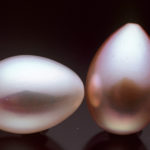
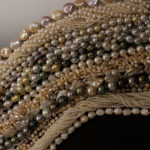 Keshi Pearls are small non-nucleated pearls typically formed as by-products of pearl cultivation. They are always baroque or unusual shaped and found in wide range of pastel colors.
Keshi Pearls are small non-nucleated pearls typically formed as by-products of pearl cultivation. They are always baroque or unusual shaped and found in wide range of pastel colors.
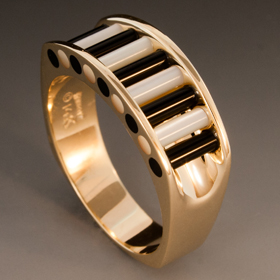
A simple cylinder of color, not traditionally set but constructed like a master craftsman’s dowel joint, inside the design of one of John Kennedy’s Aperture settings is mesmerizing. Light plays within his Cylettes cut gemstones in a non traditional way. The gems have no facets and they are not cabochons or crystals; they are different. The design is clean, classic, sophisticated and yet simple. It is remarkable innovative, so instinctive that it looks like it should have always been this way.
Growing up in Massachusetts, Kennedy had no formal training as a jewelry designer. Self-taught as a bench jeweler as well as designer, his creativity was not stifled by rules of what one can and cannot do in the traditional sense of design. Lack of formal training, combined with his endless imagination, presented a myriad of challenges.
Kennedy began his first collection with cylindrical shapes indifferent metals creating uniquely linear designs. To add color, John began brushing platinum bars and using colored gold to contrast the white and yellow gold he used in his settings. After painstakingly producing a few sample pieces he was awarded a place in the Intergold Design Competition. It was not long after that he began to see his linear designs showing up in other manufacturers’ catalogs.
Undeterred, he continued to push his imagination to higher levels; now on a quest to add more color and light to his collection. He felt limited by his materials and began to design pieces incorporating colored gemstones. His idea seemed simple, however issues soon arose. How do you cut a gemstone into a cylinder, not just a tube, but a perfectly calibrated cylinder? And once you have those cylinders, how do you set them?
Once the design goal was clear, the next challenge was to find a gem cutter who could supply him with the materials. He had found a gem cutter in Idar-Oberstein, Germany, but the quality, uniformity and calibration was not consistent enough for Kennedy’s designs. He scraped together enough material to create his collection in time for the 1992 New York Jewelers of America show, where his creations were enthusiastically embraced.
Kennedy continued his quest for a gem cutter. Finally, nearly 5 years after his quest began, while exhibiting his work at the Tucson Gem Show, he met Wolfgang Heringer, a 15th generation gem cutter also from Idar-Oberstein, Germany, who uttered the words Kennedy longed to hear, “I can do this.
For the first time since he started hic concept of Cylettes, Kennedy now had a reliable source for perfectly cut and calibrated gemstones.
Today, Kennedy’s Cylettes are praised amongst both his peers as well as his clients. Preferring to remain hands on in his operations, insisting on quality over quantity, his biggest problem these days is keeping up with the growing demand. Considering the road he has traveled, this is a problem he should wear as a badge of accomplishment.
When you’re at Tanglewood, Lenox, Massachusetts, in the heart of the Berkshires, be sure to visit our gallery of hand made fine jewelry, antique and estate jewelry, and fine gemstones.
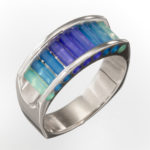 |
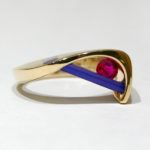 |
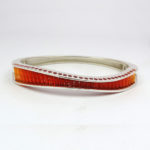 |
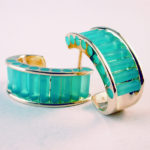 |
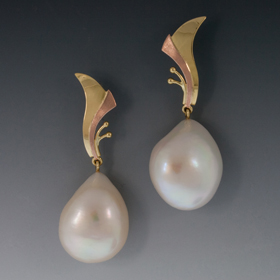
Pearl and Alexandrite are June’s birthstones. Through June, our Lenox, MA Gallery will showcase pearls in their myriad of colors and shapes. If you have a June celebration such as a graduation, birthday, anniversary, or wedding to attend, then pearls will make the perfect, classic gift.
So what exactly is a pearl? What is the ideal pearl? What are the most valuable pearls?
A pearl is a hard object produced within the soft tissue (mantle) of a living shelled mollusk. Gem quality pearls are almost always nacreous and iridescent, like the interior of the shell that produces them. Pearls have a hardness of 2.5 – 4.5 on the Mohs hardness scale.
The ideal pearl is perfectly round, smooth, and lustrous. Other shapes are known as “baroque pearls” and they often create jewelry of compelling beauty.
Pearls that occur spontaneously in the wild are extremely rare and this rarity makes them the most valuable pearl. Wild pearls are referred to as “natural” pearls as opposed to cultured pearls or “farmed” pearls that can come from both pearl oysters and freshwater mussels.
For more information on pearls, click here. For information on June’s other birthstone, Alexandrite, click here.